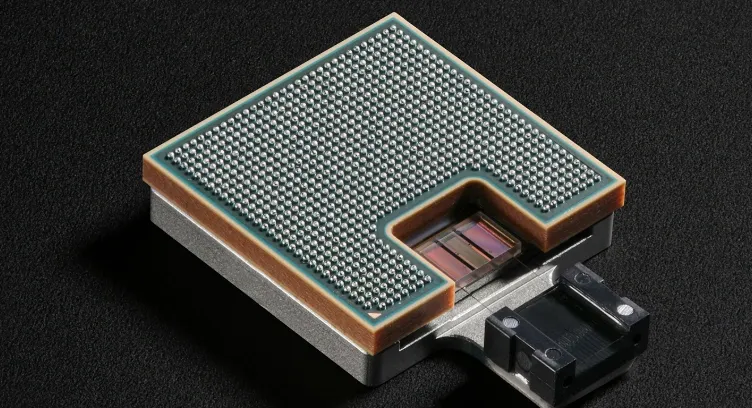IBM has announced groundbreaking research in optical technology that could reshape how data centers operate, particularly in training and running generative AI models.

The company has pioneered a process for co-packaged optics (CPO), the next frontier in optical technology, which promises to drastically enhance data connectivity at the speed of light.
This breakthrough aims to complement current copper-based electrical wires, enabling a new era of faster, more efficient data transmission within data centers.
A Quantum Leap in Data Transmission
Today, fiber optics power external communications networks, sending data across vast distances at incredibly high speeds.
However, within data centers, communication largely still relies on copper wires, which connect components like GPU accelerators.
These wires are often idle, wasting valuable energy and time, especially during large-scale, distributed training processes for AI models.
IBM’s researchers have developed a way to bring the speed and capacity of fiber optics inside data centers.
By creating a successful prototype for polymer optical waveguides (PWG), IBM has demonstrated how co-packaged optics (CPO) could revolutionize how high-bandwidth data flows between chips, circuit boards, and servers.
Key Benefits of Co-Packaged Optics
This innovation has the potential to bring significant advantages to the world of AI and data centers:
Energy Efficiency: CPO technology could reduce energy consumption by more than five times compared to traditional electrical interconnects.
This reduction could extend the length of interconnect cables from one to hundreds of meters, improving scalability and reducing overall operational costs.
- Faster AI Model Training: Using CPO, AI models like Large Language Models (LLMs) could be trained up to five times faster than with conventional electrical wiring.
For instance, training a standard LLM could go from taking three months to just three weeks, with even greater performance gains achievable with larger models and more GPUs.
- Sustainability: This technology offers a significant environmental benefit. By improving the efficiency of AI model training, it could save enough energy to power 5,000 U.S. homes annually for each AI model trained.
Future-Proofing Data Centers for AI’s Growing Demands
As AI continues to push the boundaries of what’s possible, data centers must evolve to meet the increasing demands for processing power.
IBM’s breakthrough with CPO technology promises to make data centers more sustainable and efficient, preparing them for the AI workloads of tomorrow.
Dario Gil, SVP and Director of Research at IBM, emphasized the importance of this advancement: “As generative AI demands more energy and processing power, the data center must evolve – and co-packaged optics can make these data centers future-proof.”
Achieving Speed and Capacity
One of the most remarkable aspects of this technology is its potential to vastly increase the bandwidth between chips.
With the introduction of high-density optical structures and multi-wavelength channels, IBM’s research suggests that optical interconnects could deliver up to 80 times more bandwidth than current electrical connections.

This breakthrough could open the door for chipmakers to add significantly more optical fibers, greatly enhancing data transfer speeds and capacity.
The ability to transmit terabits of data per second, using fibers just a few times the width of a human hair, represents a quantum leap in chip-to-chip communication.
The new optical interconnects will not only increase speed but also provide greater flexibility in data center architecture, extending the reach of optical communication to hundreds of meters.
Proven Reliability and Durability
In addition to speed and capacity, IBM has ensured that this technology is also reliable.
The research team has subjected the new CPO modules to rigorous testing, including high-humidity environments and extreme temperatures, to ensure they can withstand the physical stresses of real-world applications.
The results were promising: the modules passed all stress tests, showing that they could bend without breaking or losing data integrity.
IBM’s successful demonstration of polymer optical waveguides at an 18-micrometer pitch is a testament to the robustness of this innovation. Stacking multiple waveguides could allow for up to 128 channels for connectivity, offering unmatched potential for future-proofing data center networks.
New Era for AI and Data Centers
IBM's advancement in co-packaged optics is a significant leap forward in semiconductor technology, building on its legacy of innovation.
The company has long been at the forefront of developing cutting-edge chip technologies, including the first 2-nanometer node chips and various semiconductor breakthroughs.
The development of CPO technology takes AI and data center performance to new heights, promising faster processing, lower costs, and enhanced energy efficiency.
As AI continues to grow in importance, this research could redefine how data centers operate, ensuring they can handle the AI-driven demands of the future.
With its expertise in chip design and packaging, IBM is positioning itself to lead the charge in the next phase of computing, where optics will play a pivotal role in enabling faster, more efficient AI processing.
The future of data centers, powered by CPO, is here—and it promises to transform the way we train and deploy AI models on a massive scale.







